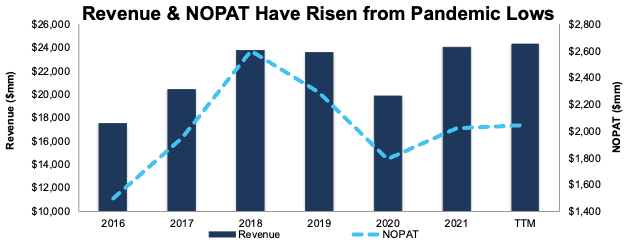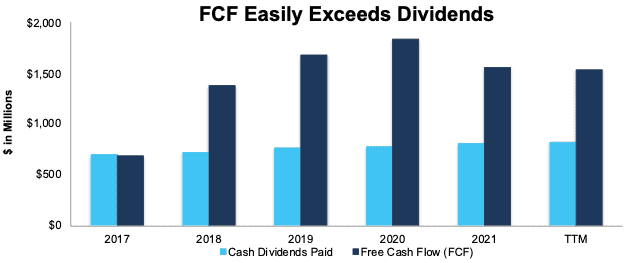Three stocks were added to our Dividend Growth Stocks Model Portfolio this month, which was made available to members on June 29, 2022.
Recap From May’s Picks
On a price return basis, our Dividend Growth Stocks Model Portfolio (-6.5%) underperformed the S&P 500 (-6.4%) by 0.1%, and on a total return basis, the Model Portfolio (-6.3%) underperformed the S&P 500 (-6.0%) by 0.3%. The best performing stock was up 9%. Overall, 17 out of the 30 Dividend Growth Stocks outperformed the S&P 500 from May 27, 2022 through June 27, 2022.
This model portfolio mimics an “All Cap Blend” style with a focus on dividend growth. Selected stocks earn an Attractive or Very Attractive rating, generate positive free cash flow (FCF) and economic earnings, offer a current dividend yield >1%, and have a 5+ year track record of consecutive dividend growth. This model portfolio is designed for investors who are more focused on long-term capital appreciation than current income, but still appreciate the power of dividends, especially growing dividends.
This report leverages our cutting-edge Robo-Analyst technology to deliver proven-superior[1] fundamental research and support more cost-effective fulfillment of the fiduciary duty of care.
Featured Stock From June: Cummins Inc. (CMI: $195/share)
Cummins Inc. (CMI) is the featured stock from June’s Dividend Growth Stocks Model Portfolio. We made Cummins a Long Idea in November 2018, and since then the stock is up 32% compared to a 41% gain for the S&P 500. CMI still offers excellent risk/reward, as detailed in our August 2021 update here.
Cummins has grown revenue by 7% compounded annually and net operating profit after-tax (NOPAT) by 6% compounded annually over the past five years. Cummins’ NOPAT margin fell from 8.6% in 2016 to 8.4% over the trailing twelve months (TTM), while invested capital turns improved from 1.4 to 1.5. Rising invested capital turns drove Cummins’ return on invested capital (ROIC) from 12% in 2016 to 13% over the TTM. The company’s economic earnings, the true cash flows of the business, rose from $793 million to $1.2 billion over the same time.
Though pandemic-related disruptions contributed to a 22% year-over-year (YoY) decline in NOPAT in 2020, the company’s TTM NOPAT is 14% above 2020 levels.
Figure 1: Cummins’ NOPAT & Revenue Since 2016
Sources: New Constructs, LLC and company filings
FCF Exceeds Dividends by Wide Margin
Cummins has increased its dividend in each of the past 13 years. The company increased its regular dividend from $4.21/share in 2017 to $5.60/share in 2021, or 7% compounded annually. The current quarterly dividend, when annualized, equals $5.80/share, and provides a 3.0% dividend yield.
More importantly, Cummins’ strong free cash flow (FCF) easily exceeds the company’s growing dividend payments. From 2017 – 2021, Cummins’ cumulative $7.1 billion (26% of current market cap) in FCF is nearly twice the $3.8 billion in dividends paid out, per Figure 2. Over the TTM, the company generated $1.5 billion in FCF and paid out $819 million in dividends.
Figure 2 also shows that Cummins’ FCF significantly exceeded its dividend payments in four of the past five years.
Figure 2: Free Cash Flow vs. Regular Dividend Payments
Sources: New Constructs, LLC and company filings
Companies with FCF well above dividend payments provide higher quality dividend growth opportunities because we know the company generates the cash to support a higher dividend. On the other hand, the dividend of a company where FCF falls short of the dividend payment over time cannot be trusted to grow or even maintain its dividend because of inadequate free cash flow.
Cummins Has Upside Potential
At its current price of $195/share, CMI has a price-to-economic book value (PEBV) ratio of 0.8. This ratio means the market expects Cummins’ NOPAT to permanently decline by 20%. This expectation seems overly pessimistic for a company that has grown NOPAT by 6% compounded annually over the past five years.
If Cummins’ NOPAT margin rises to 9% (three-year average vs. 8% TTM) and the company grows NOPAT by just 4% compounded annually for the next decade, the stock would be worth $325+/share today – a 67% upside. See the math behind the reverse DCF scenario.
Should the company grow NOPAT more in line with historical growth rates, the stock has even more upside. Add in Cummins’ 3.0% dividend yield and history of dividend growth, and it’s clear why this stock is in June’s Dividend Growth Stocks Model Portfolio.
Critical Details Found in Financial Filings by Our Robo-Analyst Technology
Below are specifics on the adjustments we make based on Robo-Analyst findings in Cummins’ 10-K and 10-Qs:
Income Statement: We made $666 million in adjustments with a net effect of removing $108 million in non-operating income (<1% of revenue). Clients can see all adjustments made to Cummins’ income statement on the GAAP Reconciliation tab on the Ratings page on our website.
Balance Sheet: We made $6.6 billion in adjustments to calculate invested capital with a net decrease of $477 million. The most notable adjustment was $1.6 billion (9% of reported net assets) in other comprehensive income. Clients can see all adjustments made to Cummins’ balance sheet on the GAAP Reconciliation tab on the Ratings page on our website.
Valuation: We made $8.4 billion in adjustments with a net effect of decreasing shareholder value by $2.6 billion. The most notable adjustment to shareholder value was $2.0 billion in excess cash. This adjustment represents 7% of Cummins’ market value. Clients can see all adjustments to Cummins’ valuation on the GAAP Reconciliation tab on the Ratings page on our website.
This article originally published on July 7, 2022.
Disclosure: David Trainer, Kyle Guske II, Matt Shuler, and Brian Pellegrini receive no compensation to write about any specific stock, style, or theme.
Follow us on Twitter, Facebook, LinkedIn, and StockTwits for real-time alerts on all our research.
[1] Our research utilizes our Core Earnings, a more reliable measure of profits, as proven in Core Earnings: New Data & Evidence, written by professors at Harvard Business School (HBS) & MIT Sloan and published in The Journal of Financial Economics.


